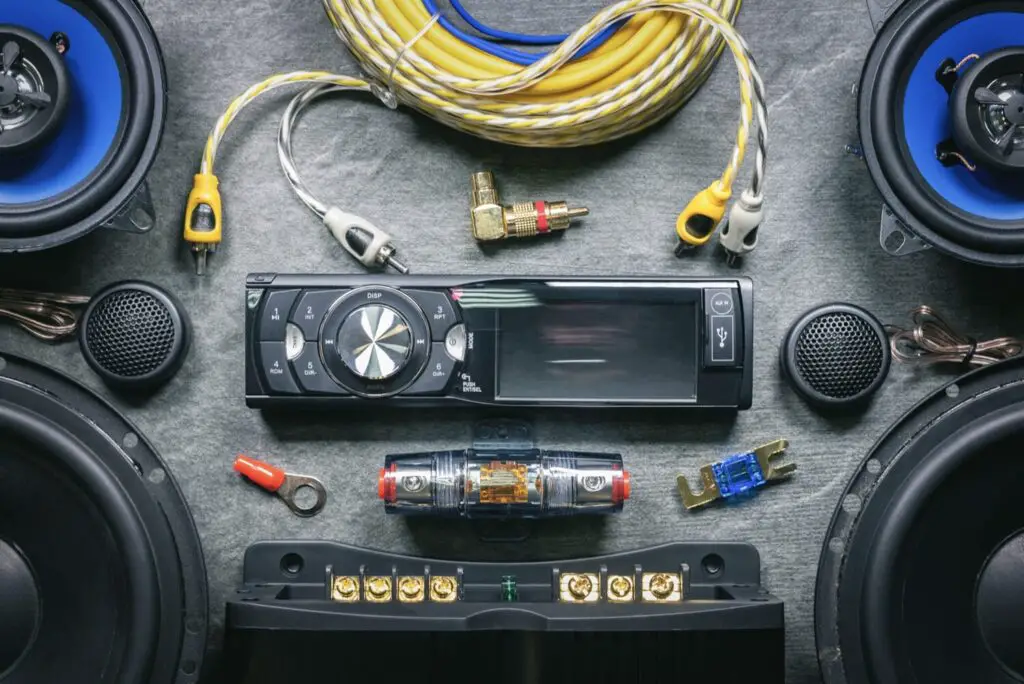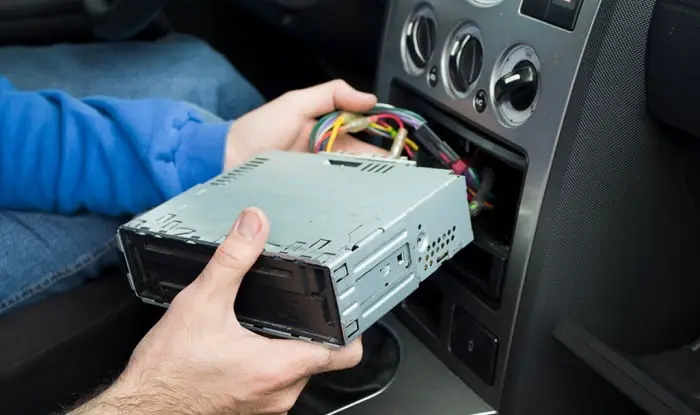A road trip without good music is like a car without wheels—somehow incomplete. The significance of a quality car audio system goes beyond just sound; it sets the rhythm for an enjoyable driving experience. In this comprehensive guide, we’ll dive into the realm of car audio installation, emphasizing the pivotal role it plays in enhancing your time behind the wheel.
Beyond the jargon and complexity, we’re here to provide a step-by-step walkthrough, empowering you to install a car audio system seamlessly. Join us as we embark on this journey to amplify your driving pleasure through the installation of a stellar car audio setup.

Preparing for Installation
Equipment and Tools
Gather necessary tools and equipment for a smooth installation:
- Wiring Harnesses: Compatible harnesses for seamless integration with the vehicle’s wiring.
- Speakers: Upgraded speakers suited for the car model.
- Head Unit: New head unit or stereo system compatible with the vehicle’s specifications.
- Wiring Tools: Wire strippers, crimpers, electrical tape, and connectors for proper wiring connections.
Safety Precautions
Prioritize safety throughout the installation process:
- Battery Disconnection: Disconnect the car battery to avoid electrical hazards during the installation process.
- Wiring Caution: Handle wiring carefully, ensuring proper insulation and avoiding short circuits.
Removing the Old System

Removing the Head Unit
Safely remove the existing head unit or stereo system:
- Disconnect Power: Turn off the car and disconnect the battery to avoid electrical mishaps.
- Trim Removal: Use appropriate tools to remove the trim panels around the head unit.
- Disconnect Wiring: Carefully detach wiring harnesses and antenna connections from the head unit.
- Head Unit Removal: Unscrew mounting screws/clips and slide out the old head unit/stereo.
Removing Speakers
Step-by-step process for speaker removal:
- Panel Removal: Access speakers by removing door panels or grilles, depending on their location.
- Disconnect Wiring: Gently detach speaker wiring, taking note of positive and negative connections.
- Speaker Extraction: Unscrew mounting screws and carefully remove the old speakers, avoiding damage to surrounding components.
Approaching the installation with the necessary tools, a focus on safety, and a systematic removal of the old system lays the groundwork for a successful car audio upgrade. Following these steps diligently ensures a smooth transition from the old to the new, minimizing the risk of damage and ensuring a seamless installation process.
Wiring and Installation Process
Wiring Harness Connection
Steps for wiring harness connection:
- Identification: Match the new wiring harness with the car’s harness by color or use a wiring diagram for compatibility.
- Connection: Use crimp connectors or soldering to secure matching wires—positive to positive and negative to negative.
- Insulation: Properly insulate connections using electrical tape or heat shrink tubing to prevent short circuits.
Mounting the Head Unit
Securely install the new head unit into the dashboard:
- Mounting Kit: Use a compatible mounting kit to fit the new head unit into the dash opening.
- Slide and Secure: Slide the head unit into the mounting sleeve and secure it using screws or clips provided.
- Reassemble Trim: Reattach trim panels around the head unit, ensuring a snug fit without obstructing functionality.
Installing New Speaker
Speaker Wiring
Connecting and securing new speakers to the car’s wiring system:
- Matching Wiring: Match speaker wiring with the car’s wiring—positive to positive and negative to negative.
- Secure Connections: Use crimp connectors or soldering and insulate connections properly for a secure fit.
Speaker Placement
Optimal positioning for better sound quality:
- Balanced Placement: Install speakers in locations that provide balanced sound distribution throughout the vehicle.
- Avoid Obstructions: Ensure speakers aren’t obstructed by panels or grilles, allowing sound to propagate freely.
Following these steps meticulously ensures a seamless installation process for the new head unit, speakers, and wiring connections. Proper matching and connection of wiring harnesses, secure mounting of the head unit, and strategic speaker placement all contribute to enhanced sound quality and a professional installation finish.
Testing and Fine-Tuning
Testing the System
Steps to ensure the audio system functions correctly:
- Power On: Reconnect the car battery and power on the new audio system.
- Functionality Test: Test each audio component—head unit, speakers, and all sources (radio, CD, Bluetooth, etc.) for proper functionality.
- Sound Check: Play different music genres to assess sound quality and ensure all speakers are producing sound.
Sound Adjustment
Fine-tuning settings for an enhanced audio experience:
- Equalizer Settings: Adjust bass, treble, and mid-range frequencies on the head unit’s equalizer for desired sound quality.
- Balance and Fader: Set the balance and fader settings to achieve balanced sound distribution across all speakers.
Troubleshooting and Tips
Troubleshooting Common Issues
Addressing potential installation problems and solutions:
- No Power: Check wiring connections, fuses, and ensure the head unit is receiving power.
- Audio Distortion: Verify wiring connections, speaker polarity, and equalizer settings.
- No Sound from Speakers: Check speaker wiring and connections to ensure they’re properly secured.
Additional Tips
Further guidance for a successful installation:
- Manual Reading: Refer to manuals for the head unit and speakers to understand all functionalities and settings thoroughly.
- Professional Help: If encountering persistent issues or discomfort with installation, seek professional assistance for a seamless experience.
FAQs
Why is Testing the Car Audio System Important After Installation?
Testing the newly installed car audio system is crucial to ensure everything functions as intended. This process verifies proper wiring connections, checks for any installation issues, and confirms the functionality of all components—head unit, speakers, and audio sources.
Testing allows users to identify potential problems early on, ensuring a hassle-free and enjoyable audio experience while driving.
How Do I Troubleshoot Common Issues After Installing a Car Audio System?
Several common issues might arise post-installation, such as no power to the head unit, audio distortion, or lack of sound from speakers. Troubleshooting involves checking wiring connections, ensuring proper power supply, verifying speaker polarity, and adjusting settings like the equalizer.
This step-by-step approach helps identify and resolve issues, ensuring optimal performance of the new audio system.
Wrap Up
In the realm of car audio upgrades, meticulous installation, testing, and fine-tuning yield the desired sound experience. Methodically installing components, testing functionality, and adjusting settings ensure a seamless transition to a superior audio system. Troubleshooting potential issues and seeking professional guidance when needed further refines the installation process.
Ultimately, the culmination of these steps guarantees not just the installation of a new system but the creation of an enhanced auditory journey, elevating the driving experience to new, melodic heights.
